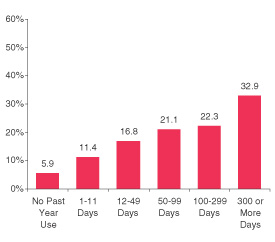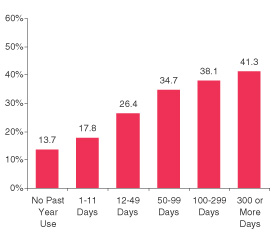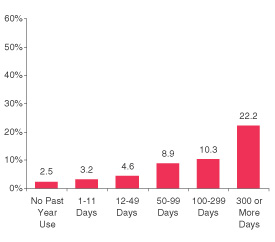
 |
| January 9, 2004 |
|
In Brief |
|
Research suggests that among youths, frequency of marijuana use is associated with problem behaviors,1,2 including delinquent behaviors. The National Survey on Drug Use and Health (NSDUH), formerly the National Household Survey on Drug Abuse (NHSDA), asks youths aged 12 to 17 to report how often they engaged in the following delinquent behaviors during the past year: (a) serious fighting at school or work, (b) taking part in a fight where a group of friends fought against another group, (c) attacking someone with the intent to seriously hurt them, (d) stealing or trying to steal anything worth more than $50, (e) selling illegal drugs, or (f) carrying a handgun.3 Youths also are asked whether they used marijuana or hashish during the past 12 months. Past year marijuana users are asked how many days they used marijuana or hashish during the past year.
Figure 1. Percentages of Youths Aged 12 to 17 Participating in Delinquent Behaviors One or More Times in the Past Year: 2002 |
Figure 2. Percentages of Youths Aged 12 to 17 Who Took Part in Serious Fighting at School or Work in the Past Year, by Frequency of Past Year Marijuana Use: 2002 |
 |
 |
Figure 3. Percentages of Youths Aged 12 to 17 Who Sold Illegal Drugs in the Past Year, by Frequency of Past Year Marijuana Use: 2002 |
Figure 4. Percentages of Youths Aged 12 to 17 Who Stole or Tried to Steal Anything Worth More Than $50 in the Past Year, by Frequency of Past Year Marijuana Use: 2002 |
 |
 |
Figure 5. Percentages of Youths Aged 12 to 17 Who Attacked Someone With the Intent to Seriously Hurt Them in the Past Year, by Frequency of Past Year Marijuana Use: 2002 |
Figure 6. Percentages of Youths Aged 12 to 17 Who Took Part in a Group-Against-Group Fight in the Past Year, by Frequency of Past Year Marijuana Use: 2002 |
 |
 |
Figure 7. Percentages of Youths Aged 12 to 17 Who Carried a Handgun in the Past Year, by Frequency of Past Year Marijuana Use: 2002 |
 |
| The National Survey on Drug Use and Health (NSDUH) is an annual survey sponsored by the Substance Abuse and Mental Health Services Administration (SAMHSA). Prior to 2002, this survey was called the National Household Survey on Drug Abuse (NHSDA). The 2002 data are based on information obtained from 68,216 persons aged 12 or older, including 23,645 youths aged 12 to 17. The survey collects data by administering questionnaires to a representative sample of the population through face-to-face interviews at their place of residence.
The NSDUH Report is prepared by the Office of Applied Studies (OAS), SAMHSA, and by RTI in Research Triangle Park, North Carolina. Information and data for this issue are based on the following publication and statistics: Office of Applied Studies. (2003). Results from the 2002 National Survey on Drug Use and Health: National findings (DHHS Publication No. SMA 03–3836, NHSDA Series H–22). Rockville, MD: Substance Abuse and Mental Health Services Administration. Also available on-line: http://www.oas.samhsa.gov. Because of improvements and modifications to the 2002 NSDUH, estimates from the 2002 survey should not be compared with estimates from the 2001 or earlier versions of the survey to examine changes over time. |
| The NSDUH Report (formerly The NHSDA Report) is published periodically by the Office of Applied Studies, Substance Abuse and Mental Health Services Administration (SAMHSA). All material appearing in this report is in the public domain and may be reproduced or copied without permission from SAMHSA. Additional copies of this report or other reports from the Office of Applied Studies are available on-line: http://www.oas.samhsa.gov. Citation of the source is appreciated. |
|
 This page was last updated on May 16, 2008. |